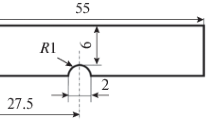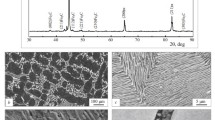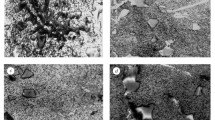Conclusions
The degree of dispersion and size distribution of the excess carbides depend significantly upon the composition of P/M high-speed steels. Refinement of the carbides reduces fracture toughness and with broadening of their size distribution curve the strength drops. Carbon supersaturation is an economical and effective method of dispersion of the structure of the investigated alloys and increase of the quantity of carbide phases for the purpose of improving wear resistance. The maximum effect is obtained in selection of a steel composition in which after hardening the only excess carbides are MC carbides.
In the opinion of the authors the mechanism of influence of AC on structure is related to high cooling rates (103–105 deg/sec) of the powder in spraying and the position of the high-speed steel on the phase diagram relative to the eutectic composition.
An increase in AC has both a positive and a negative influence on the properties of P/M high-speed steels and the optimum supersaturations must be selected taking into consideration the required level of hardness, strength, and toughness in relation to the specific service conditions.
Similar content being viewed by others
Literature cited
I. R. Handyside, I. C. Hamaker, and D. H. Yates, “Rc 70 high-speed steel — its development, properties, and performance,” Met. Progr., No. 6, 78–82 (1963).
Yu. A. Geller, Tool Steels [in Russian], Metallurgiya, Moscow (1983).
Yu. A. Geller, L. S. Kremnev, and B. L. Aleksandrovich, “The heat resistance and secondary hardness of cobalt high-speed steels with an increased carbon content,” Tool and Bearing Steels [in Russian], No. 3, Metallurgiya, Moscow (1976), pp. 5–10.
A. Kazak and E. I. Dulis, “Powder metallurgy tool steel,” Powder Met.,21, No. 2, 114–121 (1978).
Yu. M. Skrynchenko, A. K. Petrov, G. I. Parabina, et al., “Basic properties and working capacity of P/M high-speed steel,” New Types of Tool and Bearing Steels [in Russian], Metallurgiya, Moscow (1986), pp. 4–12.
K. Yu. Sokol'chuk, Yu. M. Skrynchenko, and M. R. Orlov, “The fracture toughness and strength of P/M high-speed steels,” Metalloved. Term. Obrab. Met., No. 1, 29–32 (1988).
S. A. Saltykov, Stereometric Metallurgy [in Russian], Metallurgiya, Moscow (1976).
E. L. Exner, I. R. Pickend, and I. Gurland, “A comparison of indentation crack resistance and fracture toughness of five WC-Co alloys,” Met. Trans.,9A, No. 5, 1736–738 (1979).
H. F. Fischmeister and L. R. Olsson, “Fracture toughness and rupture strength of high speed steel,” Cutting Tool Materials, Metals Park, Ohio (1981), pp. 111–131.
L. A. Savina, “Transformation of carbides in high-vanadium high-speed steel produced by the P/M method,” Author's Abstract of Candidate's Dissertation, Moscow (1983).
Yu. M. Skrynchenko, K. Yu. Sokol'chuk, T. N. Zvegintseva, et al., “The influence of alloying on the structure of P/M high-speed steels,” Problems of Investigation of the Structure of Amorphous Metallic Alloys [in Russian], Mosk. Inst. Stali i Splavov, Moscow (1988), pp. 505–506.
Author information
Authors and Affiliations
Additional information
Translated from Poroshkovaya Metallurgiya, No. 10 (346), pp. 64–69, October, 1991.
Rights and permissions
About this article
Cite this article
Skrynchenko, Y.M., Sokol'chuk, K.Y. Influence of the ratio between carbon and carbon-forming elements on the structure and mechanical properties of P/M high-speed steels. Powder Metall Met Ceram 30, 865–869 (1991). https://doi.org/10.1007/BF00795859
Received:
Issue Date:
DOI: https://doi.org/10.1007/BF00795859




